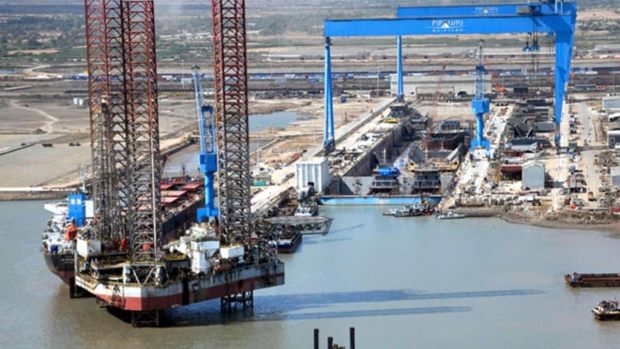Why the revival of Pipavav Shipyard matters for India’s shipbuilding capabilities?

On December 29, Ahmedabad based special bench of the National Company Law Tribunal (NCLT) approved the resolution plan submitted by Hazel Mercantile Ltd (HML) to acquire Reliance Naval and Engineering Ltd (RNAVAL), formerly known as Pipavav Ship Dismantling and Engineering Limited.
This marks the new beginning of the company which is going through a corporate insolvency resolution process (CIRP) since January 2020.
Swan Energy is in a strategic partnership with HML through a special purpose vehicle (SPV) named Hazel Infra Ltd (HIL) to acquire RNEL. Swan Energy, owned by Gujarat-based businessman Nikhil Merchant, has a 74 per cent stake in the SPV while the balance is held by Hazel Mercantile.
The story of RNEL from one of the largest private shipbuilders to its recent bankruptcy reflects the sordid state of the affairs in expanding the ships’ design and development capabilities beyond the realm of government-owned defence entities.
Make in India for naval warships
While the Indian Defence Public Sector Undertaking (DPSUs) has progressed on naval warship design and manufacturing, private players remain on the fringe. Building upon the policy direction towards greater indigenisation of India’s warship procurement, the Ministry of Defence has laid the ground for private players to start bidding for naval warships for the Indian Navy.
The Indian Navy plans to have 175 ships under its capability roadmap. The warships are needed for a variety of roles like surveillance missions, escort operations, deterrence, search and attack and coastal defence.
RNAVAL plunged into the manufacturing of the ships, becoming the first private sector company to obtain the licence and contract to build warships in India. The company operates India’s largest integrated shipbuilding facility with a dry dock. The facility houses the only modular shipbuilding facility in the country with the capacity to build fully fabricated and outfitted blocks, spread over 2.1 million sq ft of space.
In its heydays, RNAVAL, which was then called Pipavav Defence and Offshore Engineering Company Limited (PDOC) managed to successfully deliver five Panamax bulk carriers. Besides, PDOC was one of the first Indian defence entities to be awarded an overseas contract to build two specialised offshore vessels for its European client.
Despite the early orders from the Indian navy, the bankruptcy of Pipavav was a blow to private defence manufacturers. The cancellation of the 5 offshore vehicles due to delays in delivery was another blow to the company. While mismanagement remained an issue, the cancellation of such contracts nipped its growth in the bud, says Commodore Sujeet Samaddar, former naval adviser to Niti Aayog who monitored the development of projects closely.
He further outlines that the opportunities not only lie in the military domain but present a wider scope in commercial shipbuilding activities, including Off-Shore Patrol Vehicles (OPVs).
Given the tussle in geopolitics and increasing conflict in grabbing resources, the stakes are getting bigger in the maritime arena.
“The scale is humungous, given the fact that material requirements will jump from 79Gt in 2011 to 167 Gt by 2060, energy requirements will cross 24Gt, and competition can be predicted since much of this requirement would be consumed by China and India,” says Samaddar, pointing out the number of ships that India would require to fulfil the demand and supply of maritime trade. He also highlights the DPSU’s inability to build such a large number of ships.
The story goes beyond the specific contractual fallout. It highlights concerns over the neglected woes of private shipbuilders from financing to project cancellation. And on top of that, the need for massive investment is a well-established fact in the capital-intensive shipbuilding industry.
The shipbuilding challenges
It is unfathomable that despite building the indigenous aircraft carrier INS Vikrant and stealth destroyers like Vishakhapatnam, shipbuilding in India makes up only a tiny part of economic activity.
Today, China, along with Japan and South Korea, accounts for almost 90 per cent of the world’s shipbuilding capacity, while Indian shipyards only contribute a minuscule 0.045 per cent.
India has 28 shipyards – six are public sector undertakings (PSUs), two are owned by state governments, and the remaining 20 are in the private sector. Despite the number of private shipyards on the list, many are sitting idle and most ship-builders are debt-ridden. The reason is the dominance of DPSUs in securing orders with the exception being Larsen and Toubro (L&T).
Former Naval Chief Admiral Arun Prakash highlights the state of affairs: “Statistics show that nearly 90 per cent of government orders, consisting of warships and submarines for the Indian Navy and patrol vessels for the Coast Guard, are placed on the public-sector shipyards, whose order books always remain full. For reasons mentioned earlier, few shipping companies wish to order merchant ships on private Indian yards.”
Again, recalling the cancellation of OPVs by the Indian Navy, Commodore Samaddar explains that had the contacts moved ahead, the navy could have saved a few thousand crores, given the low cost of the OPVs then at Rs 2500 crores, which costs now Rs 6000 crores for the similar contract. “In fact, the demand for such OPVs is massive worldwide and India could have exported to its neighbouring countries,” he adds.
For India’s maritime economy, the strategic significance of the Indo-Pacific needs no reiteration. The region accounts for 65 per cent of the world’s GDP, 63 per cent of the world’s population and a little over 50 per cent of global trade. The Sea Lines of Communications (SLOCs) crisscrossing across the Indo-Pacific provide access to minerals, materials and markets that are the bedrock of every economy in the region and beyond. The resurgence of private shipbuilding companies can fill the gaps in building a maritime economy as well as secure maritime security. The revival of Pipavav Shipyard (now RNAVAL) is a step in that direction.
Source: Financial Express



